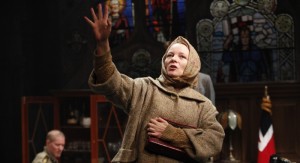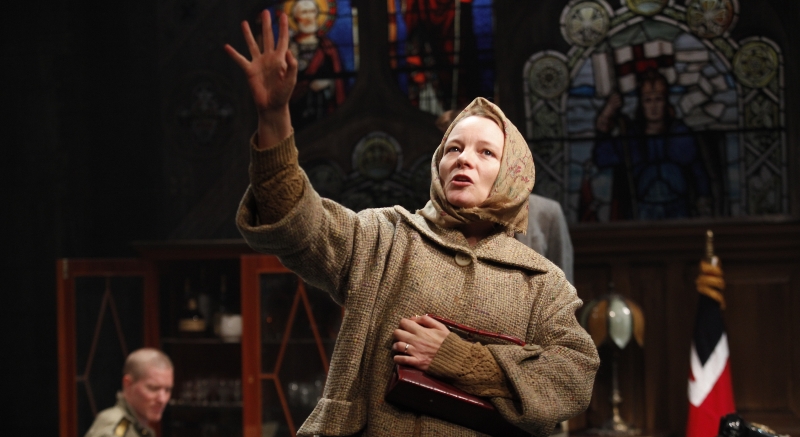
Cara Seymour (as Lily, foreground) in Brian Friel’s THE FREEDOM OF THE CITY at Irish Repertory Theatre (132 West 22nd Street), directed by Ciaran O’Reilly. For more information, visit http://www.irishrep.org. (Photo credit: Carol Rosegg)
The knowledge that death is inevitable brings with it a certain freedom. It alleviates fret over details in the vain hope of altering an assured outcome and, more importantly, it allows for deep introspection into the conditions surrounding that outcome. When done well, historical drama exploits this freedom to its fullest, capitalizing on the seeming rigidity of historical fact in order to scrutinize any apparent certainty about the characters and contexts that make history happen.
Brian Friel’s great 1973 play, THE FREEDOM OF THE CITY, now receiving an excellent revival at The Irish Repertory Theatre, doubles down on the inevitability of death, first in taking its inspiration from the deadly events of Bloody Sunday in the Northern Ireland town of Derry City, and secondly by opening with the corpses of its three principle characters strewn across the stage. Throughout the play, time will flash backward and forward, but by freeing itself immediately from any pretense of sugar-coating history, THE FREEDOM OF THE CITY proves itself far more interested in exploring the conditions, reactions, and most of all the people at the heart of making history.
Set in 1970, THE FREEDOM OF THE CITY is an only slightly concealed dramatization of Bloody Sunday, the 1972 day when British soldiers opened fire on Northern Irish civil rights protesters, killing 13 and precipitating at least one later death. The aftermath only exasperated tensions, as a British-lead investigation concluded that nobody was responsible for the deaths, and none of the soldiers were charged or disciplined.
The play (which Friel has said he began writing prior to Bloody Sunday, but completed with an eye toward the massacre) opens with the macabre image of three bullet-riddled bodies lying onstage, accompanied by the sounds of helicopters, gunfire, and shouts of an angry mob. A photographer grabs some shots, a priest hurries to administer hasty last rites, and the scene immediately shifts to the cold staleness of a British judge interrogating soldiers in what he calls “a fact-finding exercise” about the deaths; a snapshot of more chaos follows, and then we are greeted by a sociologist lecturing on the subculture of poverty; quickly the scene shifts back to the violence that erupted during a clash between British soldiers and Irish civil rights marchers, a gas canister explodes, and three protesters scramble for cover in what they will soon discover is the mayor’s private chambers of the Derry City guildhall. Over the course of the play, the scene shifts regularly and abruptly between several times and places, managing to give us event, context, and aftermath in one frenetic narrative.
The result can be dizzying, but director Ciaran O’Reilly does a masterful job managing the play’s chaos. The Irish Rep’s space is small and uniquely laid out, but O’Reilly has embraced these limitations as assets to the production. Immersing audience members into the world of the play by littering the theater with armed and surly military officers who patrol the theater and stage as people shuffle into their seats, the show immediately puts us on notice that we are entering a tense and volatile environment. Not even the seating area is depoliticized: the walls of the theater are painted with political slogans, and barbed wire reaches out from the stage into the auditorium. Throughout the play, performers will use every available access to the playing space—the rear of the theater, the side by the restrooms, a variety of onstage doors—delivering lines as easily from the aisles as from center stage. THE FREEDOM OF THE CITY attempts to encapsulate the panic and chaos of thousands of people on Bloody Sunday, and through the innovative use of space and design, O’Reilly has managed to do just that with only an ensemble of nine in a tiny theater.
The play’s most specific focus amidst the chaos is the three protesters who have found themselves inside the belly of the political beast that they had gathered to protest. They are two men in their twenties—Michael (James Russell), a principled political idealist, dedicated fully in heart and mind to the cause, and Skinner (Joseph Sikora), a drifter bordering on nihilism, driven by cynicism and fits of anger—and a woman of forty-three, Lily (Cara Seymour), mother of eleven who lives in a two-room tenement with a husband unable to work and a toilet in the yard shared by eight families. All are members of the oppressed Catholic faction in Northern Ireland, but each has come to the march for their own reasons: Michael on strong principle, Lily mostly to get out of the house for some exercise, and Skinner seemingly because he had nothing better to do that day.
The pleasantries and politeness between the three quickly evolve as Michael grows suspicious that Skinner may be part of “the hooligan element” from which dignified protesters like Michael work so hard to distance themselves, and Skinner’s mercurial temper threatens to alienate the others and dissect group unity. More problematically for the three, conflicting and exaggerated reports of their activities are circulating in the media and among the British forces: “unconfirmed reports are coming in that a group of about fifty armed gunmen have taken possession of the Guildhall,” says a news reporter. Tension builds as these three who find themselves spending a quiet Sunday afternoon drinking municipal booze in the cozy parlor of the mayor begin to realize that the tanks and gunmen outside consider them a far greater threat than they are, and this reality begins to strain their ideals and camaraderie.
The greatness of this play, skillfully captured by The Irish Rep, is its examination of both the large-scale chaos and the quiet inside, of both the storm and its tenuously peaceful eye. O’Reilly and the performers give the parlor scenes a sense of strained isolation from the storm encroaching on all sides, and offset that quietude with a feverish whipping around the many ancillary contexts, from the military, to the judiciary, to the media, to the church. Lighting and stage design (Michael Gottlieb and Charlie Corcoran, respectively) are used subtlety to great effect in distinguishing time and space. This play demands a complex and complicated set, efficiently incorporating a number of intersecting playing spaces, and The Irish Rep rises admirably to that challenge.
Strong individual performances abound in this production, but it is mostly a true ensemble play, with nine actors (some taking on multiple roles) working in service of the play at large. This is a dynamic well suited to THE FREEDOM OF THE CITY, dedicated as it is to exploring the big-picture of a grizzly historical event, from individuals through events to socio-political context. THE FREEDOM OF THE CITY is a play about how history is made by people and their interactions, and this production revels in the play’s mandate to examine critically that very process.
THE FREEDOM OF THE CITY
by Brian Friel
Directed by Ciaran O’Reilly
Through November 25, 2012
The Irish Repertory Theatre
132 West 22nd Street
New York, NY, 10011
212-727-2737
http://www.irishrep.org/


